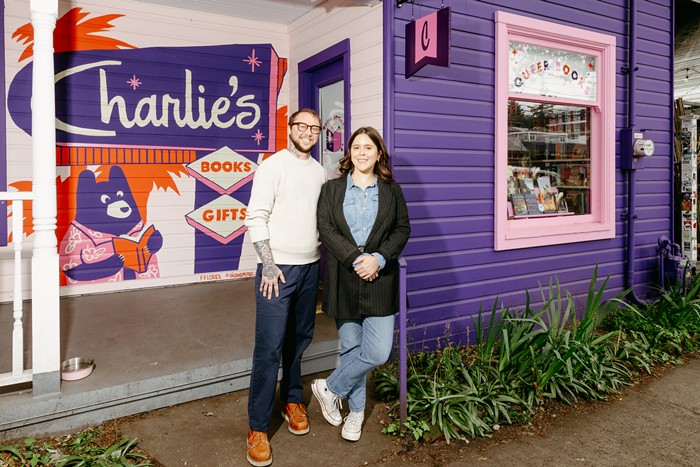Every scene needs its scribe, and you won't find a wonkier, more meticulous, more measured historian of Seattle's rock scene in the 1980s and '90s than Clark Humphrey.
Longtime readers of this paper will remember Humphrey from his MISC column, which he wrote for The Stranger from 1991 to 1998. He was also the creator of the late, lamented X-Word and a wry generalist who wrote movingly and humorously about Seattle's cultural landmarks.
He's since written a big handful of books, including a city guide of Seattle (Walking Seattle) and a photo history of Belltown, but his most impressive contribution to the city remains Loser: The Real Seattle Music Story, which was originally published in 1995 and was designed and laid out by Art Chantry, whose band posters and album art helped define the aesthetics of the scene. The book is a 200-plus-page encyclopedia of bands that played on Seattle, Tacoma, and Olympia stages during the so-called grunge era.
On Sunday at Vermillion, Humphrey and company will be launching a new edition of the book, now complete with 16 new pages, rescanned images, and several updates on the musicians. I caught up with Humphrey by phone.
What was your editorial philosophy for compiling the entries?
The concept was to tell the full, multi-plot soap-opera story line. And to treat the people who didn't become global superstars as just as important as the people who did.
In what way?
It shows the people who influenced other people and who were part of the great miasma of the scene. People like Rob Morgan of the Squirrels, and bands like 7 Year Bitch.
7 Year who?
They influenced Sleater-Kinney and were around at the same time as some of the Olympia riot grrrl bands. They were making very loud, assertive rock anthems with an all-female lineup. They didn't take any shit from anybody.
In Seattle Met, Gillian Gaar says: "Despite [Clark Humphrey's] claims, Seattle's first punk show wasn't before London's." What's that about?
Basically, I counted the first punk show in London as one that took place in July 1976, and she believes there were shows before then. I will certainly let her interpret the chronology the way she prefers to. My version of the story is that you could count that July show as being a coming-out party for punk in Britain, but it doesn't matter as far as my story line goes because I'm writing about the music that starts here. I was referring to the TMT show that was on May Day 1976, in the Odd Fellows building. One of the performers there, Bill Rieflin, is still performing today. He's worked with everybody from King Crimson to R.E.M. to Robyn Hitchcock.
All these names. I love the band names "Full Toilet" and "Diarrhea Planet." Can you think of a band name from that era that brightens your day?
Oh yeah. There was one called Lapses in Grammar (Afforded to Avoid Sexism).
There have been a few oral histories of this era, right? Grunge Is Dead by Greg Prato and Everybody Loves Our Town by Mark Yarm come to mind. How does Loser differ?
Well, Loser was written during the time. I happened to be here. Whereas, with some of the other oral histories, people had to go around and interview people who were here. I cover a somewhat wider swath of the scene than some of them do. I include people like the Young Fresh Fellows, the Posies, Sky Cries Mary, and bands that were not directly called grunge.
Are you avoiding the term "grunge" in this book for a reason?
No, except for the reason that the book is about a much wider theme than just one sound. And I say that there was no one Seattle sound. Even TAD and Soundgarden and Alice in Chains didn't sound much like one another.
You write that there was no "Seattle sound" but there was a "Seattle attitude," which you describe as one of actively trying to "demolish" the "corporate rock pantheon." Was this era basically just a photo negative of the corporate rock sound?
There were people who prided themselves on being opposed to it. One of the terms in the Olympia scene was the "corporate ogre." But there were also people actively making their own sounds, and making their own "brand-images," as it were, and basically doing it all without having the big-money boys telling them what to do.
Why rerelease the book now?
The music industry as it was then basically doesn't exist anymore. And it's hard for some people to imagine just what it was like when there were giant corporations landing down in a city, grabbing acts, grooming them for success, and then kicking them out when they didn't succeed by the corporation's standards. It was a whole different world then, a whole different machine to rage against.
What's the machine to rage against now?
Certainly in today's Seattle there's the douche-bro monoculture that has taken over Pike/Pine on weekend nights and basically made life miserable or too expensive for the rest of us. And in the broader culture there is—oh god—there are so many things to protest against, including the resurgence of stupid racist bigotry and everything that goes with that, and also what feminists have called rape culture.
As for the music business itself, it's become not so much a matter of taking it apart—because it's already been taken apart. It's now a matter of putting something better back together, which includes labels like Barsuk and Hardly Art, and, in the retro-sphere, Light in the Attic. It includes things like the MOTOR records/Debacle Fest scene. It includes people like Tacocat and THEESatisfaction and Childbirth.
Do you see this book as assisting that mission in any way?
In showing the roots of that mission, yes. The people who came before—like Calvin Johnson and Slim Moon and Bruce Pavitt—created street-level organizations that existed to help artists rather than just exploit them. ![]()




















